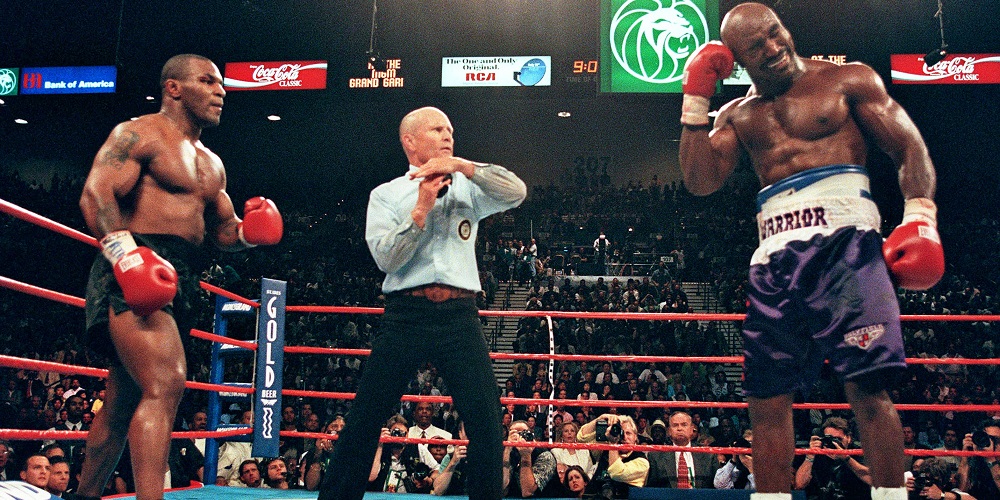Dizzying Heights and Devastating Lows: “Iron” Mike Tyson’s career was a runaway train on a roller coaster, a pendulum swinging ceaselessly between the glory of champions and the oblivion of outcasts. Exactly twenty-seven years ago, on June 28, 1997, one of the most sensational and controversial chapters of his troubled history unfolded: the infamous ear bite that led to his disqualification in the rematch against Evander Holyfield and effectively marked the end of his career at the highest levels.
The Never-Digested Defeat and Return to Roots
“Tyson vs. Holyfield” was already being talked about in 1988 when The Real Deal moved up to the heavyweight division after unifying the cruiserweight belts. Since then, due to various setbacks, the last of which was Tyson’s incarceration for sexual assault, the much-anticipated clash had been continually postponed until it finally saw the light in November 1996. The Iron Mike who emerged from prison displayed his usual rock-solid physique, but the quick victories that led him to the coveted battle were not sufficient to reveal to the world the extent to which the real Tyson had returned to dominance. The 1996 fight, in fact, provided very different answers from what the fans of Cus D’Amato’s former pupil expected: Tyson, after a promising start, quickly faded, relying on isolated and predictable punches instead of his characteristic fast combinations and was easily neutralized by Holyfield, in a crescendo of suffering interrupted by referee Mitch Halpern at the beginning of the eleventh round.
Tyson realized that night that to beat someone like Evander, sheer power would never be enough: to prevail in the rematch, he would have to bring back the boxing style that had made him great, the style involving lightning-fast slips, sudden counters, and lethal combinations. Having irreparably damaged his relationship with his former mentor Kevin Rooney, Mike contacted Richie Giachetti, the trainer who had helped him recover from the shocking defeat to James Douglas and who had guided him until the day of his incarceration. The plan was as simple as it was ambitious: to reclaim the moves of the golden years and reclaim the top of the world in his own way.
Headbutts and Bites: More Than a Boxing Match, a Street Fight
The highly anticipated rematch took place in Las Vegas nearly eight months after the first fight and generated the highest economic returns in boxing history up to that point. An unusually disciplined and cautious Mike Tyson began the fight by focusing mainly on defense, slipping under his opponent’s punches with constant dodges and carefully rationing his offensive efforts as likely suggested by Giachetti. Holyfield, on the other hand, started with great determination, trying to surprise Mike with his aggression and prevent him from finding the confidence to unleash. Therefore, the first two rounds, though without dramatic turns, were clearly won by the champion, but the most significant damage he inflicted on the challenger did not come from a punch, but from a headbutt. Two short and fast fighters, used to closing the distance explosively, can easily be involved in such collisions, but years later, doubts remain about whether Holyfield’s head thrust forward during exchanges was entirely in good faith.
What triggered Iron Mike’s reaction at that point is hard to say. Perhaps it was the headbutts and the resulting ugly cut, perhaps it was the frustration from the less-than-brilliant start, perhaps it was the pressure associated with the risk of definitive demotion, or maybe it was a mix of these and other factors that created a short circuit in the mind of the powerful puncher. In the middle of a third round where he was noticeably improving and had already landed a couple of well-placed right hands, Tyson spat out his mouthguard during a clinch and bit down violently on the champion’s right ear, then pushed him on the back as Holyfield turned around, vehemently protesting the incident. The experienced referee Mills Lane immediately noticed the act and, after about two minutes of stoppage in an increasingly surreal atmosphere, decided to penalize the challenger by two points and let the fight continue. Unfortunately, the brief forced pause was not enough to calm an out-of-control Tyson, and in the final seconds of the round, another attempt to bite Holyfield’s left ear led to the inevitable disqualification. The consequences of that horrible sports page were very severe for Tyson. More than the $3 million fine, the revocation of his license, which kept him out for a year and a half, proved disastrous, inevitably leading to his ultimate decline. However, what matters most is that, although 27 years ago anger, hatred, and violence were on full display in that Las Vegas ring, those rancors have been swept away by the passage of time. Tyson and Holyfield have fully reconciled, to the point where it was Mike himself who welcomed Evander into the International Boxing Hall of Fame in 2017, presenting him to the public with the words, “A friend of mine, one of the greatest champions of all time.”

